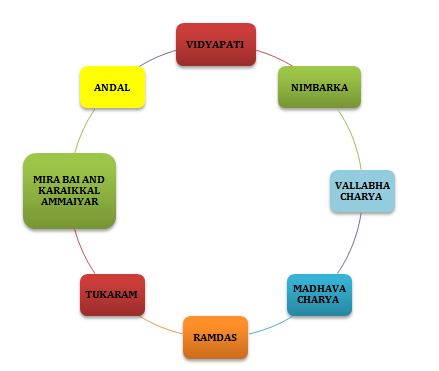

The seeds of Bhakti have been found in Vedas and worship of Lord Vishnu has started from that time. The female saints here used to reject all roles of women and all societal rules or guidelines against women and left their houses in order to become wandering bhaktas and remain involved in the Bhakti movement.
The word bhakti denotes devotion or a passionate love for the divine or gods. Several traces of the mystical union of the people with God have been found in the bhakti movement. According to some scholar, the bhakti movement was a reaction against feudal oppression and the denomination of Rajput and Brahmin.

Another group of scholars thinks that the movement emerged due to changes in socio-economic conditions of the early medieval age. The movement was based on equality and devotional surrender to the divine and supreme god. The 2 major ideological streams of this movement were Saguna and Nirguna.
Some major salient features that highlight the early tradition of the Bhakti movement are mentioned below
The Bhakti movement was generally based on monotheism principles that were used to criticize the worship of idols.
The devotees of the bhakti movement generally preached the universal brotherhood principle.
The reformers also emphasized the necessity of self-surrender for gaining grace of god and bliss and for valuing the Guru's importance who used to act as people’s guides and preceptors.
Saints of bhakti movements were against the rituals, pilgrimages and fasts and used to oppose the caste system strongly as it divide people from their birth.
Saints like Alvars and Nayanars used to lead the bhakti movement of the 8th Century and before that. The role played by these saints is stated below.
Alvars − The persons who are immersed in devotion to Lord Vishnu are referred to as alvars.
Nayanars − The persons who are denoted as the devotees of Lord Shiva are referred to as Nayanars.
Alvars and Nayanars used to travel to several places singing Tamil hymns to praise their gods .
Both of these saints generally initiated the movement to protest against the dominance of Brahmanas and the caste system of that time.
The Nalayira Divya Prabandham was determined as the composition of major anthologies of 12 layers that are compiled and collected by Nathamuni in the 10th century.
Tevaram was determined as the collection of the first Tirumurai’s 7 volumes that include Saiva devotional poetry. Poetry was the major work of Tamil poets including Appar, Sambandar, and Sundarar.
Various reformers of this movement used to believe in freedom from the cycle of life and death. Reformers of the bhakti movement also believed that one can gain salvation if he or she attains deep devotion and have faith in God. Some prominent leaders of this movement are listed below
Shankaracharya (788 – 820 CE)
Ramanuja (1017 – 1137 CE)
Madhavacharya (1238 – 1317 CE)
Nimbarka
Vallabhacharya (1479 – 1531 CE)
Vidyapati (1352 – 1448 CE)
The women's poetic saints or devotes played a vital role in the Bhakti movement. This movement was a highly male-dominated movement and this was the major reason why women have to stove harder to gain acceptance. Women of the time remain involved in this movement besides performing all thier household duties. Some well-known women saints of this movement are listed below.
Mira or Mirabai − She belongs to a higher class ruling Raputans family who left her family and husband son of Rana Sanga of Mewar and went on a pilgrimage at an early age. Mira portrays a devotee bride of Lord Krishna to the world.
Andal − She was the only female Alwar and was the beloved of Lord Vishnu .
Akkamahadevi − She was the bhakti saint of the 12th century, from the southern region of Karnataka. She got the title Akka from some philosophers of that time. The philosophers include Basavanna, Prabhu Deva, Madivalayya and Chenna Basavanna. She was one of the devotees of Lord Shiva.
Bahina or Bahinabai − She was the poetic saint of 17th century, Maharashtra and wrote various abhyanga, which are referred to as women’s folk songs portraying the working life of a woman
Karaikkal Ammaiyar − Among 63 Nayanars she was a women Nayanars who is the devotee of Lord Shiva. She adopted the asceticism path to achieve her goal.
The Bhakti movement in Maharashtra was divided into major sections including Varakaris and Dharakaris. Here, the Varakaris were referred to as bhakts of God Vitthala of Pandharpur, who were emotional, theoretical and abstract in their beliefs. Dharakaris were referred to as heroic followers of cult of Ramadasa who were the devotee of Lord Rama. Rama was denoted as rational, concrete and practical in his thinking.
Q. Who were the major leaders of the bhakti movement in Maharashtra?
The Bhakti movement in Maharashtra was centred around the shrine of Vitthal or Vithoba. This movement used to preside over the deity of Pandharpur, who was determined as the manifestation of Lord Krishna. The major leaders of this movement include Jnanadeva, Namadeva, Sant Eknath, Tukaram, and Ramdas
Q. What are the main differences between Saguna and Nirguna
Saguna highlighted the poetic saints who composed verses that extolled a god with a unique form. On the other side, Nirguna used to highlight the poetic saints extolling gods who are beyond all forms. Nirguna was also denoted as Monotheistic Bhakti saints. The major leaders of Saguna include Tulsidas, Chaitanya, Surdas and Meera and in the case of Nirguna Nanak and Kabir are the main leaders.
Q. Who was Nimbarka?
Nimbarka was the contemporary young of Ramanuja who proposed 2 major philosophies including Dvaita Advaita and Bheda Abheda. He was the founder of Sanak Sampradaya and preacher of Vaishnavite Bhakti situated in the region of Telangana.